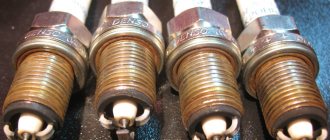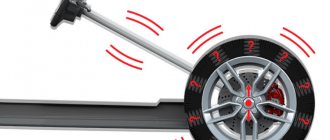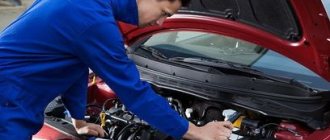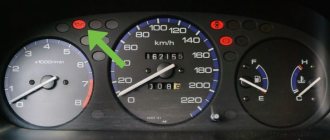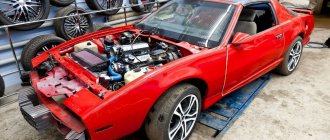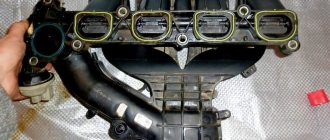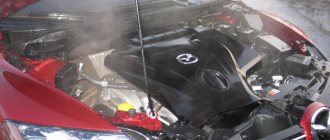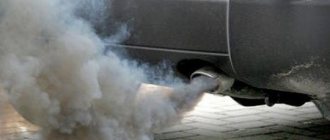Ride comfort is a critical component through which automakers grow their customer base. Silence in the cabin, absence of vibrations and extraneous sounds are key components that many buyers prioritize when it comes to choosing a specific vehicle model.
- What you can check and fix yourself
- Chassis imbalance
However, during operation, such an unpleasant phenomenon as engine vibration often occurs. They significantly reduce the level of comfort and cause reasonable fears among owners.
After all, this indicates a malfunction of individual components and mechanisms of the machine. Why the engine vibrates, which causes an excessively intense “heartbeat” of the car, and how to get rid of it, will be discussed in our material today.
Engine vibration - is this normal?
Every motorist knows his car and literally feels and hears by touch whether everything is in order with it.
Vibrations are no exception - if you suddenly begin to feel the steering wheel, gear lever, pedals and the entire car rattling, and this was not the case before, this is already an alarming signal. Such rattling may indicate serious damage to the engine, in particular in its cylinder-piston group, and this already threatens costly repairs. Vibrations at low speeds are normal within reasonable limits, since the motor can enter into slight resonance at a low frequency of its own vibrations. This is most often observed at idle, during cold starts or stopping the engine.
Let's sum it up
As you can see, the causes of engine vibrations at low speeds and idle pose a danger to the car engine and its individual parts. Any vibrations not only impair operating comfort, but also harm the engine.
Only timely recording of the above signs of vibration, immediate elimination of the causes, as well as regular technical inspection are the key to long and safe operation of the internal combustion engine and the entire vehicle.
Sources
- https://FB.ru/article/162048/vibratsiya-na-holostyih-prichinyi-i-metodyi-ustraneniya
- https://scart-avto.ru/remont/vibratsiya-dvigatelya-na-holostyh-oborotah-prichiny-pochemu/
- https://diagnozbibike.ru/neispravnosti-dvigatelya/vibracziya-dvigatelya-na-holostyh/
- https://nahybride.ru/dvigatel/vibratsiya-dvigatelya-na-holostyh-oborotah
- https://avtodvigateli.com/neispravnosti/vibraciya-na-xolostyx-oborotax.html
- https://dvigatels.ru/uhod/vibraciya-dvigatelya-na-holostyh.html
- https://avtodvigateli.com/neispravnosti/vibraciya-dvigatelya-na-xolostyx.html
- https://KrutiMotor.ru/vibratsiya-dvigatelya-na-malyh-oborotah-prichiny/
Causes of engine vibrations in different operating modes
Vibration can be observed both constantly, regardless of engine speed and warming up, and during certain operating modes - at idle, when starting cold or hot, at low or high speeds while driving.
Low speeds during idling of the internal combustion engine often lead to slight vibration of the entire car, including the steering wheel. While there is no clutch and the engine does not transmit power to the wheels, it operates at a minimum speed of 800-1000 rpm. If the tachometer shows lower or higher values, this is already a reason to contact a service station, but this is also an average indicator, which may differ in both directions depending on the make and model of the car.
Resonance often occurs when the engine is started cold, and when it reaches normal speed, the vibration goes away after warming up for 3-5 minutes. If the engine continues to vibrate at idle after starting or while driving, i.e. when hot, and the vibrations themselves become more and more noticeable, this already indicates a malfunction. Among them, car service experts identify five main ones:
- Incorrect motor mounting. This problem often occurs when the car is repaired unprofessionally and the engine is disassembled. Lack of balancing and improper mounting can all lead to vibrations when starting cold or hot, when idling and while the vehicle is moving.
- Faulty engine mounts. This problem can arise by itself under extreme operating conditions of the car or be a consequence of the previous point - improper disassembly and reassembly of the engine, violation of the car repair technology, etc. With this type of malfunction, a cold engine vibrates especially noticeably. This is due to the fact that the polymer elements of the motor mounts lose their elasticity when cooled and do not fully perform their damping functions. After the engine warms up, the vibration stops due to the restoration of the shock-absorbing properties of the gaskets.
- Unbalanced crankshaft. A loose crankshaft leads to pendulum oscillations of the engine, which resonates with the small vibrations of the car, creating a powerful vibration that is noticeable in the cabin. Vibration with an unbalanced crankshaft can be observed both at idle when starting cold or hot, and while the car is moving.
- Vibrations when starting the engine when cold can also be observed with faulty fuel injectors. Simply put, an insufficient amount of fuel enters the combustion chamber, which prevents the combustion of the air-fuel mixture and leads to triple combustion.
- Engine tripping. This is the most common reason for engine vibration at idle. In addition to malfunctions in the fuel system, problems in the cylinder-piston group itself often lead to tripping, incl. wear of its elements and friction surfaces. Uneven operation of the cylinders introduces the engine into vibration resonance precisely at low idle speeds. While driving, when the engine is running under load, this effect is not so noticeable.
Jerking and jerking of the engine, leading to general vibration of the machine, appears as a result of uneven distribution of the load on the crankshaft. Even if you press the gas pedal at idle, thereby compensating for the drop in power and speed due to an inactive cylinder, the driver will still feel a noticeable vibration. It is transmitted to the steering wheel, through which drivers most often detect suspicious rattling, and it can also be transmitted to the hood, which literally begins to drum.
Engine oil additive "Suprotek Active Plus"
Restores compression, reduces fuel consumption and oil waste, reduces wear rate and extends the life of internal combustion engines of any type. Facilitates cold starts and protects against overheating in traffic jams.
more reviews
How to determine the cause of vibration and eliminate it?
The first step is to determine the root cause of vibration and then boldly eliminate it.
- Check the fuel system and spark plug operation.
- If the engine has recently been repaired and disassembled, check the quality of its fastening at a service station.
- Make sure the support pads are in good condition.
- The runout of an unbalanced crankshaft can be either an independent cause of vibration or a consequence of malfunctions in the CPG.
Troubleshooting is the most common cause of vibration in an engine at idle. This malfunction can be detected at a service station. However, you can notice the signs of tripling yourself.
- More frequent misfires.
- Frequent popping sounds from the exhaust pipe.
- Significant reduction in engine power.
- Vibrations from the engine compartment at idle, transmitted to the steering wheel.
- Darkening of the spark plug in an idle cylinder.
- Long acceleration times and jerks when accelerating.
- Increased fuel consumption.
It is necessary to eliminate such a malfunction as quickly as possible, since this exponentially leads to aggravation of the problem, further breaking the pistons, cylinder cups and crankshaft. During triplication, unburned fuel washes away the lubricant in the engine cylinders, increasing the coefficient of friction and accelerating wear of the rubbing surfaces of the cylinder-piston group.
Diagnostics of a vibrating motor and further work
Based on everything described above, it is easy to imagine what an engine check and diagnostics in general will include. Experts recommend entrusting all work related to checking the engine and adjacent components to specialists at a service station . Here's what they'll do:
- Check the performance of the injection system or carburetor;
- They will take readings from the pressure sensor and tachometer, and then compare them with standardized readings;
- They will check all the mounting elements of the engine and some other heavy units;
- Carry out computer diagnostics.
When the cause of vibration is identified, it is immediately eliminated. It is often necessary to adjust the engine and fuel pump. Here you cannot do without knowing the factory values. In theory, an ordinary car enthusiast can easily cope with such work. What he definitely cannot do is replace some parts himself. When the cause of vibration lies in the cylinder-piston group, contact a specialist and entrust all the work to him.
What causes tripling?
The problem may be hidden in a non-working spark plug or a violation of the insulation of the electrical wiring supplying it. This can be determined independently by visual inspection. Masters carry out more detailed diagnostics of the ignition system by transferring the spark plug's power supply to ground. If the engine stalls, the cylinder is working properly; if it does not stall, it is not working.
If all cylinders are working, i.e. in them the air-fuel mixture ignites, then the cause of the tripping and accompanying engine vibration is the wear of the cylinder-piston group. This may be due to scratches, chips, scuffs and other damage to the mirror of the cylinder cups and piston, as well as if the integrity of the sealing rings is damaged.
As a result of CPG wear, a significant decrease in compression in the cylinders is observed. This leads to jerky operation of the engine with the appearance of vibration, which intensifies due to resonance at idle.
Through scratches and chips on the friction surfaces of the CPG, engine oil penetrates into the combustion chamber, and fuel and exhaust gases penetrate in the opposite direction. This dramatically worsens the rolling of the pistons and leads to unbalance of the crankshaft. Such loose operation of the entire cylinder-piston group, including the crankshaft, causes strong resonating vibrations at idle speeds during cold starts and even while the car is moving at low speeds.
Engine vibration may go away briefly after changing the engine oil, but this is a temporary effect. Without eliminating the root cause, the oil in the crankcase will again acquire negative properties that disrupt the normal operation of the cylinder-piston group. If scratches and chips remain on the rubbing surfaces of the cylinder and piston, exhaust gases and fuel will again enter the crankcase through them.
This problem can be eliminated not only by replacing the entire CPG at a service station, but also with the help of special tribological reducing compounds that are added to the engine oil.
How do engine oil additives help with engine vibration?
Motor oil directly affects the quality of operation of the cylinder-piston group and the entire combustion process of the air-fuel mixture in the cylinder. Lubricity, detergent properties, uniform distribution over the surface and stability of the oil film are all key factors for the normal trouble-free operation of all engine parts. Additives that improve these properties of motor oil prevent the formation of scuffs, scratches and other defects on the friction surfaces in the CPG, and therefore contribute to the uniform operation of the entire engine without jerking and vibration.
Best driving instructors:
Automotive instructor Svetlana Automatic transmission: Hyundai Accent Trains in Northern Administrative Okrug, North-Western Administrative Okrug, Khimki REVIEWS
Driving instructor Elena Automatic transmission: Chevrolet Lacetti Teaches in the Southern Administrative District, South-Eastern Administrative District, Vidnoye, Domodedovo REVIEWS
Driving instructor Marina Automatic transmission: Kia Cerato Manual transmission: Chevrolet Lanos Trains in Northern Administrative Okrug, Dolgoprudny REVIEWS
Automotive instructor Irina Automatic transmission: Kia Cerato Trains in SZAO, JSC REVIEWS
Driving instructor Natalya Automatic transmission: Kia Spectra Teaches in the Eastern Administrative District, Balashikha, Reutov REVIEWS
Driving instructor Oleg Automatic transmission: Chevrolet Lacetti Manual transmission: Chevrolet Lanos Trains in Northern Administrative Okrug, Dolgoprudny REVIEWS
Driving instructor Yana Automatic transmission: Kia Spectra Teaches in the Northern Administrative Okrug, Dolgoprudny REVIEWS
Driving instructor Yulia Automatic transmission: Chevrolet Lacetti Manual transmission: Chevrolet Lanos Trains in the Eastern Administrative District, South-East Administrative District, Lyubertsy, Reutov, Zheleznodorozhny REVIEWS
Automotive instructor Svetlana Automatic transmission: Chevrolet Lacetti Trains at Northwestern Administrative Okrug REVIEWS
Driving instructor Tatyana Manual transmission: Chevrolet Lanos Automatic transmission: Kia Spectr Teaches in Krasnogorsk REVIEWS
Driving instructor Peter Manual: Daewoo Nexia Trains at Northwestern Administrative Okrug REVIEWS
Automotive instructor Oksana Automatic transmission: Hyundai Accent Teaches in North-Eastern Administrative District, Mytishchi, Korolev, Pushkin REVIEWS
Driving instructor Dmitry Automatic transmission: Volkswagen Golf Manual transmission: Chevrolet Lanos Trains in North-East Administrative District, Northern Administrative District, North-Western Administrative District, Dolgoprudny REVIEWS
Driving instructor Oksana Automatic transmission: Kia Spectra Manual transmission: Chevrolet Lanos Trains in the Southern Administrative District, South-Western Administrative District, Vidnoye, Podolsk REVIEWS
Automotive instructor Dmitry Manual transmission: Lada Granta Teaches in the South-East Administrative District, Lyubertsy REVIEWS
Are all additives useful?
Not all fuel additives are useful and have a beneficial effect on the engine. Some not entirely honest manufacturers, even world-famous ones, follow the path of a little deception when, with the help of an additive, motor oil does not improve its physical and chemical properties, but only thickens. This is done to prevent oil from penetrating into the combustion chamber through chips and scratches, as well as to improve the distribution of lubricant over parts and stabilize the oil film, which, due to the reduced fluidity of the oil, remains on the rubbing surfaces longer.
Not a single professional service station technician will advise you on a thickening additive for motor oil. This is a temporary solution to the problem and, rather, even disguises it. Overly thick lubricant will even harm the engine in the long run. Each automaker recommends motor oil with certain mechanical and physico-chemical properties, since the operation of the engine of each specific brand is designed for certain conditions of lubrication, washing and cooling of its cylinder-piston group.
Changing such conditions will lead to overload and overheating of the engine, poor lubrication of the elements of its CPG and the washing off of carbon deposits from them. All this will certainly lead to serious damage and expensive repairs, although at first car owners notice positive changes.

